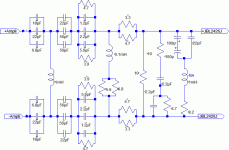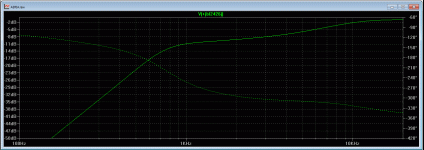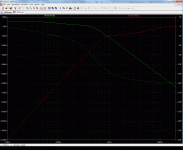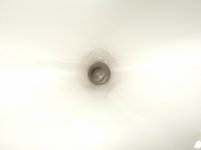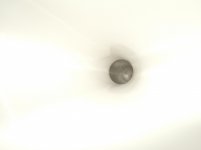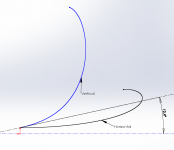I just finished reading this thread from beginning to end.
Lots of interesting ideas presented.
I had a question on compression driver exit diameter.
What are the trade-off with different compression driver throat diameters?
For example Radion makes a 1.4" and 2 " both with 3" diagrams.
I think there is even a 1" from Denevo with a 3".
Would the difference change distortion, max frequency, minimum frequency?
Perceived sound quality?
I was thinking B&C DE10 / DE7 / DE5 on the high end.
Would the DE5 work better above 8K in a LeCleac'h horn?
Regards,
Doug
Lots of interesting ideas presented.
I had a question on compression driver exit diameter.
What are the trade-off with different compression driver throat diameters?
For example Radion makes a 1.4" and 2 " both with 3" diagrams.
I think there is even a 1" from Denevo with a 3".
Would the difference change distortion, max frequency, minimum frequency?
Perceived sound quality?
I was thinking B&C DE10 / DE7 / DE5 on the high end.
Would the DE5 work better above 8K in a LeCleac'h horn?
Regards,
Doug
I think there is even a 1" from Denevo with a 3".
If this is the BA750 you speak of, turns out to be a 2" diaphragm.
Doug,I had a question on compression driver exit diameter.
What are the trade-off with different compression driver throat diameters?
For example Radion makes a 1.4" and 2 " both with 3" diagrams.
I think there is even a 1" from Denevo with a 3".
Would the difference change distortion, max frequency, minimum frequency?
Perceived sound quality?
Regards,
Doug
An exit diameter larger than the wavelength of the highest frequency of interest can cause cancellations at high frequencies and poor HF polar response, more problematic on wide dispersion horns.
A 1.4" or 1.5" exit is better from that standpoint than a 2", but there is a legacy of 2" throat horns, so both exit sizes are popular.
A 2" throat can be "pinched" down to 1" or so to mitigate the dispersion problems, but pinched throats cause other sound quality issues.
A smaller exit results in a higher compression ratio, so throat SPL is higher, on a narrow, slow expansion horn that could result in more distortion at high drive levels, more a problem for PA than home, though distortion vs. better HF is just one of the many tradeoffs in driver design.
Choosing between a 3" diaphragm, 1.4" exit, and a 2" diaphragm, 1" exit can be a difficult choice- the former better at the low end of the crossover region, the latter, better at the upper reaches of HF hearing.
As we grow older, and HF perception becomes slightly less year by year, getting the midrange right becomes more and more important.
Art
Compression Driver Throats
The exit diameter of a compression driver is arbitrary and acoustically unimportant. What matters acoustically, is diaphragm diameter and throat diameter at the immediate phase plug exit. In some cases the same motor assembly can be attached to horns of 1", 1-1/2" or 2" throats by use of different adapters that do not require a 'pinch-down' or 'fan-out' profiles.
Regards,
WHG
The exit diameter of a compression driver is arbitrary and acoustically unimportant. What matters acoustically, is diaphragm diameter and throat diameter at the immediate phase plug exit. In some cases the same motor assembly can be attached to horns of 1", 1-1/2" or 2" throats by use of different adapters that do not require a 'pinch-down' or 'fan-out' profiles.
Regards,
WHG
Thanks everyone.
Since one wavelength @ 2" is about 6500 Hz, it could potentially limit the upper crossover a bit, since the diaphragm is probably good to 8k or so.
I was thinking of starting down this path. Getting the mid-range right seems to be where the magic lives.
Doug
Since one wavelength @ 2" is about 6500 Hz, it could potentially limit the upper crossover a bit, since the diaphragm is probably good to 8k or so.
I was thinking of starting down this path. Getting the mid-range right seems to be where the magic lives.
Doug
For those who can be interested, the passive filter for JBL2426J (16 Ohms) designed by François Delamare for the first AERIA system, before the catastrophic mod done on his enclosure after his departure from the "Maison du Haut parleur".
First is a 18DB/oct classical filter at 750Hz, followed by a curve response compensation. Then the passive attenuator, then a precise ZOBEL (inductance compensation) up to 100KHz, then a motional impedance compensation.
Response curve is near a strait line up to 16JHz, as well as the impedance curve up to 100Khz.
First is a 18DB/oct classical filter at 750Hz, followed by a curve response compensation. Then the passive attenuator, then a precise ZOBEL (inductance compensation) up to 100KHz, then a motional impedance compensation.
Response curve is near a strait line up to 16JHz, as well as the impedance curve up to 100Khz.
Attachments
Last edited:
and on the same webpage you can find the spreadsheet for the calculation of the original axisymetrical Le Cléac'h horn
http://nicolas.davidenko.perso.sfr.fr/outils/axial.zip
Opening in Excel 2003 I get errors. See enclosed picture. Any help appreciated.
An externally hosted image should be here but it was not working when we last tested it.
Just want to inform you about this thread: Astos biradial lecleach wooden horns
I am a cabinet maker working in Bristol, UK.
I am starting an audio company, the first product I am producing are custom small turned 1Khz+ JMLC horns, with hopefully lots more products to follow. Picture of these solid American Black Walnut 1.6Khz and my thread with more info. Priced initially, amongst the diy community at £100 Base price, plus shipping.
If interested please reply on my thread or PM me.
http://www.diyaudio.com/forums/vendors-bazaar/216576-1khz-wooden-horns-sale-interest-3.html
Louis.
Studio Au
I am starting an audio company, the first product I am producing are custom small turned 1Khz+ JMLC horns, with hopefully lots more products to follow. Picture of these solid American Black Walnut 1.6Khz and my thread with more info. Priced initially, amongst the diy community at £100 Base price, plus shipping.
If interested please reply on my thread or PM me.
An externally hosted image should be here but it was not working when we last tested it.
http://www.diyaudio.com/forums/vendors-bazaar/216576-1khz-wooden-horns-sale-interest-3.html
Louis.
Studio Au
Thanks tinitus,
Thanks Eric(who I pm'd on the very topic) for the pictures
From what I have read/understood, better matching of the two (driver exit angle and horn throat angle), results in better response. Are there any guidelines on what this difference should be for optimum performance, and is there a point of diminishing returns?
If matching of the driver/throat angle is preferred, it would be nice for horn vendors to provide this data.
SMathews
Thanks Eric(who I pm'd on the very topic) for the pictures
From what I have read/understood, better matching of the two (driver exit angle and horn throat angle), results in better response. Are there any guidelines on what this difference should be for optimum performance, and is there a point of diminishing returns?
If matching of the driver/throat angle is preferred, it would be nice for horn vendors to provide this data.
SMathews
jzagaja,
Wow, thanks. Okay 2 angles, 2 many. Contemplating on horns for my TAD 2001 (long term project ..... like all my projects). The 2001 has an exit angle of 3 degrees. So
Edited [ OK, not 2 angles, infinite ... re-reading Eric's post]
Question : Horizontal/vertical swapped in the picture?
SMathews
Wow, thanks. Okay 2 angles, 2 many. Contemplating on horns for my TAD 2001 (long term project ..... like all my projects). The 2001 has an exit angle of 3 degrees. So

Edited [ OK, not 2 angles, infinite ... re-reading Eric's post]
Question : Horizontal/vertical swapped in the picture?
SMathews
Last edited:
- Home
- Loudspeakers
- Multi-Way
- Jean Michel on LeCleac'h horns
